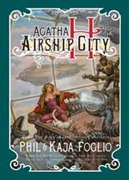 Since today is the day that Phil Foglio asked that people who plan to buy it from Amazon wait for (as well as Kaja Foglio’s birthday—happy birthday, Kaja!), today is the perfect day to review the novelization of the first part of the Girl Genius webcomic story, Agatha H. and the Airship City. This story covers the beginning of volume 1 through the end of volume 3—23 months’ worth of comic;, or a bit more than 1/4 of the comic’s overall run so far (not counting the various side stories that show up as filler).
Since today is the day that Phil Foglio asked that people who plan to buy it from Amazon wait for (as well as Kaja Foglio’s birthday—happy birthday, Kaja!), today is the perfect day to review the novelization of the first part of the Girl Genius webcomic story, Agatha H. and the Airship City. This story covers the beginning of volume 1 through the end of volume 3—23 months’ worth of comic;, or a bit more than 1/4 of the comic’s overall run so far (not counting the various side stories that show up as filler).
If I were to describe my reaction to this book in one word, it would be “ambivalent.” If I were allowed two words, it would be “extremely ambivalent.” For starters, Girl Genius is one of my all-time favorite webcomics, and one of those that I check religiously as soon as (and sometimes before) it’s gone up. I love it for the story, but I also love it for the art (even if sometimes these two likes come into conflict—I’ve been known to grumble when there’s a single or double splash page because I don’t get as much story out of those posts).
As for the novel, for starters it seems pretty obvious that the Foglios are hoping to appeal mainly to people who don’t ordinarily read comic books—get them hooked on the story and hence broaden the readership of the webcomic, which is the main way they make money. Of course, having people who are already comic fans buy the novel is going to make them money, too, but there are or will be fully eleven printed volumes of the webcomic, plus several smaller collections, to sell to comic newcomers as opposed to just a single novel to sell to comic fans after all.
You can see this emphasis in the way that the cover art style does not resemble the comic’s style in any way, shape, or form—a bit of a false note for fans of the comic, but not a turn-off for people who aren’t into comic books. And it also seems to be the intention behind Phil’s plan to have everybody buy the book today in the hope of getting it on the best-seller lists so it attracts more attention.
There’s nothing wrong with this strategy. When you give content away for free on the Internet, coming up with ancillary works that make money is how you can afford to continue giving the stuff away for free that you do. It’s just that I’m not sure how well it will really work in the case of the novel.
Try as I might, I can’t project myself into the mind of someone who’s never read the comic before. It’s too deeply ingrained in my psyche. So I can’t tell how well the prose book will attract newcomers to the comics. Some reviews I’ve seen indicate it’s doing its job; others are less impressed.
On the other hand, comic fans have been anticipating the novel for getting to see more detailed information about the way the world works than graphic novel pages can convey, and there is some of that. But I’m not sure the addition makes up for what’s missing.
The novel is a faithful reproduction of the Girl Genius story—perhaps even a bit too faithful—but leaving out the art loses half the appeal to me. Of course, if a picture is worth a thousand words, a thousand words should be worth a picture, so the book attempts to fill in with descriptions what it leaves out in images. And the descriptions are good, but they can’t replace the delightfully quirky, highly-detailed, and often Easter-egg-filled art that is fully half of what I read the comic for.
The problem is that the comic story is very visually-oriented. That’s the way comics work. There are plenty of sight-gags, or multiple-frame build-ups for end-of-strip reveals. A lot of these just don’t work as well in text; to me they come off like explaining to someone why a joke is funny. But the aggravating thing is that, to be fair, I’m not really sure whether this is because the writing falls flat or just that the images are so good they’ve spoiled me for even good writing about the same events.
As I was reading the book, I kept thinking back to the comic book and wishing I could see these things again rather than just reading about them. From that perspective, it might have been nice if they could have included some of the splash pages from the comic as full-page illustrations, in the same way Phil did art for the Myth Adventures novels.
As for extra material, there is some of it, including some David-Weber-style infodumps, but for the most part it only adds color to the story, not new facts. Even the prologue with the original Heterodyne Boys only recapitulates (“precapitulates?”) material that came out later in the comic story.
Still, the story itself is the same, and it’s a good story, a classic hero(ine)’s journey about a college student who can’t get anything right who turns out to have a secret heritage she never imagined, in a wild and crazy steampunk alternate history setting. Those who’ve never had any exposure to the comic might very well be able to enjoy it on its own merits, though they might then come to the comic and find that things don’t look at all quite like they were led to imagine them.
The book is available from Amazon in print, Kindle, and audiobook formats. It’s cheaper and DRM-free from Baen, though buying it this way doesn’t have the effect on Amazon’s bestseller list the Foglios hope to achieve today.































I read Agatha H in the Webscription edition from Nightshade.
Before that I was totally unaware of the comic, so the novel is my introduction to the character and the milieu.
I *was* familiar with Mr Foglio through his work on the Starblaze editions of the MYTH-ADVENTURES and his delightful STANLEY AND HIS MONSTER mini.
My take on the novel? It works.
The writing is good; the narrative takes a bit getting to the telegraphed reveal, but the quirky low-key presentation suits the material. It came across as a whimsical fantasy with mad scientists and wacky inventors instead of sorcerors and sorceress, robots and constructs instead of demons and goblins and what-not, and has some likeable and intriguing characters. No cardboard cutouts or stereotypes out of central casting.
I’ve been recommending the heck out of it: to a friend who is fond of steampunk; to a friend with a bright tween daughter; to my mother, who like me, will read pretty much anything. I think they will all enjoy it.
I looked into the graphics novel releases and decided to pass; the cover art imagery is not in line with my “inner eye” view of the characters and their world and I fear the dissonance might get in the way of enjoying the story. Essentially, the novel and its (projected?) sequels look to be reaching to a different audience than the one already following the comic version. Which *I* think is wise simply because the material is strong enough to stand on its own in mutiple incarnations; I would not be surprised to see it optioned for a movie project at some point in either version, as an animated romp or a family-friendly live action movie.
My main question right now is: When are the sequels due? As the obvious intro to a prose novel series, the novel ends just as things get popping.
Hopefully we won’t have a long wait for the followup?
What’s the Kindle price (AMZ doesn’t show it to me)? If it’s more expensive that on WebScriptions, I wonder how Nightshade managed to pull it off, seeing as AMZ insists on the lowest price for almost everyone.
Nevermind, it’s displayed now ($7.99 for Kindle vs $6 on Webscriptions).